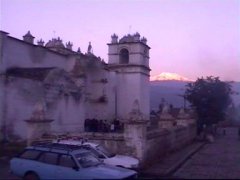 A TRANSLATION MEMOIR: 45 YEARS WITH CESAR VALLEJO
A TRANSLATION MEMOIR: 45 YEARS WITH CESAR VALLEJODr. Clayton Eshleman
For nearly forty-five years, I have been translating, off and on, the poetry of Cesar Vallejo. His writing has become the kelson in the ship of poetry I have attempted to construct. Here I would like to offer an overview of this translational companionship and to evoke some of the experiences that occurred because of it. Finally, I would like to say what this companionship has meant to me, as a poet and as a human being.
While I was a student at Indiana University in 1957, a painter friend, Bill Paden, gave me a copy of the New Directions Latin American Poetry anthology and I was particularly impressed with the poetry of Pablo Neruda and Cesar Vallejo. At the same time, I read Angel Flores’ translation of Neruda’s Residencia en la tierra, and upon comparing his version with those of H.R. Hays and Dudley Fitts in the anthology; I was intrigued with the differences. Without knowing any Spanish, I began to tinker with the versions. That summer, with a pocket Spanish-English dictionary and two hundred dollars, I hitchhiked to Mexico. The following summer I again returned to Mexico, rented a room in the back of a butcher’s home in Chapala, and spent the summer with Neruda’s poetry, as well as writing most of the poems that were to appear in my first book, Mexico & North in 1962.
The following year, I edited the English Department sponsored literary tri-quarterly, Folio, where I printed some Neruda versions I had done with friends in Mexico City, and four Vallejo versions, co translated by Maureen Lahey and myself. I had become aware of poetry in translation almost as soon as I became aware, in 1956 that poetry existed at all.
I finished a Master’s Degree in 1961, and took a job with the University of Maryland’s Far Eastern Division, teaching literature to military personnel stationed in Japan, Taiwan, and Korea. Before leaving, almost as an afterthought, I packed the copy of Poesia de America #5, Homenaje a Cesar Vallejo, that I had found in a Mexico City bookstore the first summer that I was there.
The following year, with the help of Gary Snyder in Kyoto, my first wife Barbara and I moved to Kyoto where for the next two years I mainly studied and wrote, making a living teaching English as a second language at various Japanese companies. Having completed a small collection of Neruda translations (published in San Francisco by George Hitchcock’s Amber House Press as Residence on Earth), I decided to investigate the Vallejo poems in the Mexican journal.
The first poem I tried to read was “Me viene, hay dias, una gana uberrima, politica...” It was as if a hand of wet sand came out of the original and “quicked” me in—I was quick sanded, over my head, or was it a spar Vallejo threw me? Each move I tried to make drew me farther in or farther out. I could not tell where the focus lay, between Vallejo’s poetry and my desire to write poetry, or in that part of me that wanted to evade the hard work of doing my own poetry. And how much of this difficulty had to do with my inability to read complex Spanish? I had been able to read Neruda with the help of a dictionary and my friends. With Vallejo, I was lost. Yet to turn away from him was to be more lost, found out by my inability to express anything that was “my own,” as well as to express myself in the way that I wanted to with others.